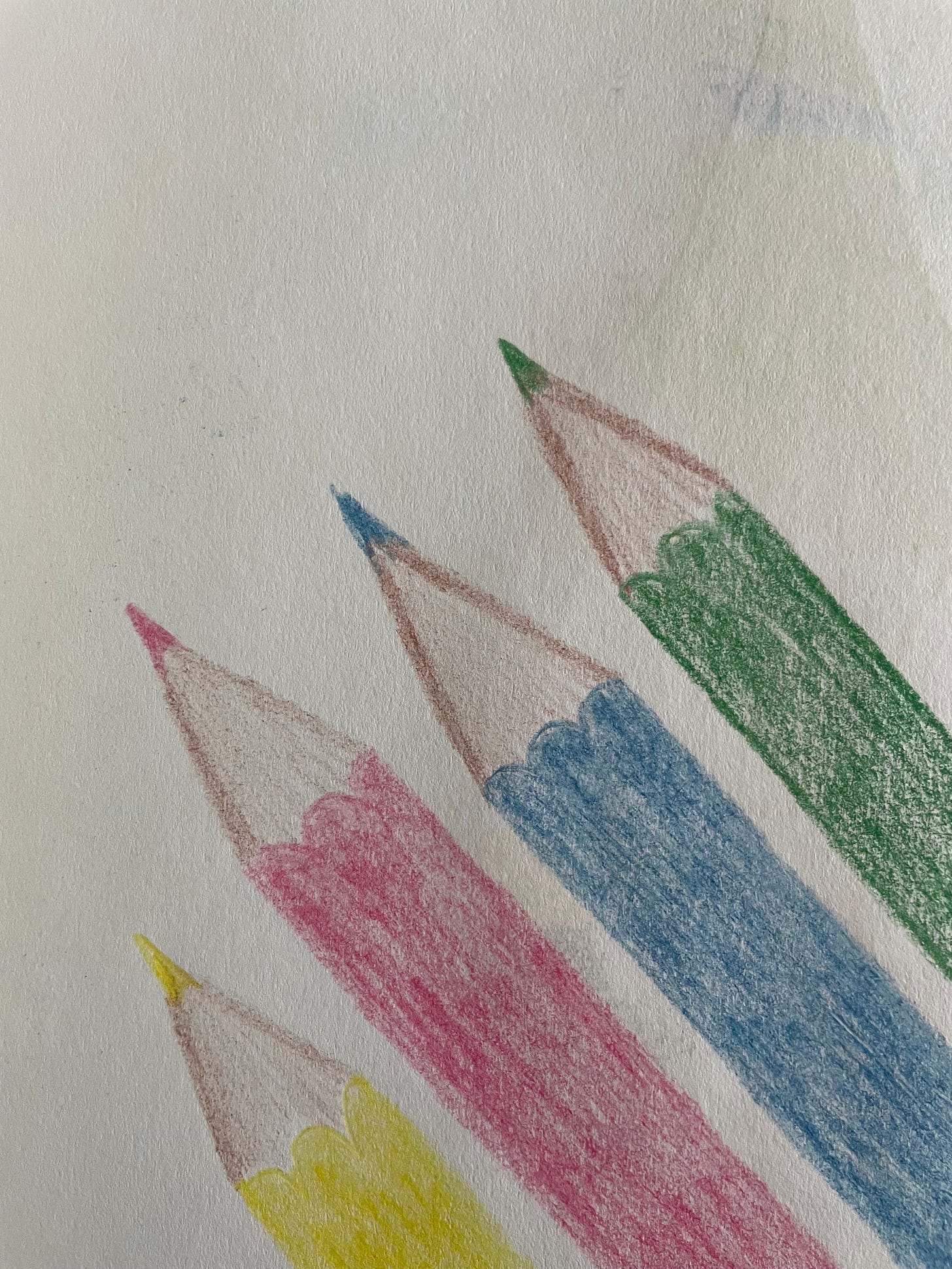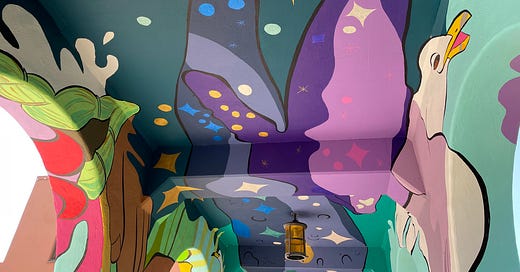Where do you find creative inspiration? 💡
Ideas are everywhere, as long as we're willing to look and listen
On a Saturday morning last month, I went to my local art museum. I’d signed up for an event in which fellow attendees and I would spend an hour “slow looking” — viewing two separate works of art, for 30 minutes each. The concept intrigued me, though admittedly, I had my doubts. Half an hour on one painting?
But as our group gathered around the first object of study (Viola Frey’s Artist Mind/Studio Diptych VIII), the hesitations gradually dissipated. Our docent, a French teacher who looked to be in her sixties, led us in a discussion. She asked us to take stock of what stood out, then prompted us to notice colors, facial expressions, and placements of certain objects.
“There’s no right answer here,” she reminded us, her gentle voice echoing off the walls. “Just share what comes to mind, what you think the artist is trying to say.”
The hour flew by. I found myself completely immersed in the company of my fellow group members. They brought up fascinating points — from noticing themes of gender politics to picking up on hidden symbols and emotions. Normally too shy to share my own thoughts in settings full of strangers, I felt comfortable and compelled enough to do so.
Once we parted ways, an excitement overcame me, and I spent another hour browsing the exhibit and checking out neighboring ones.
The whole experience reinforced beliefs I’ve been sitting with throughout the past year: the world is full of creativity, and this creativity is vital for not only our well-being, but our ability to connect with one another. And as human beings, we were designed to create.

Creativity Is Inherently Collaborative
Last year, when I was doing my interview series, I ended a few conversations with my favorite question: “What are your biggest sources of creative inspiration?”
I noticed the glimmer in the interviewees’ eyes, the exuberance with which they shared their answers — which ranged from mountain goats to children to nature. In these conversations, I learned so much, not just about the women I spoke to, but about the creative process. And creativity itself.
Previously, I saw creativity as a largely solitary pursuit. You block out the rest of the world, channel your energy into whatever endeavor you happen to be working on, and then — and only then — do you come out of your self-imposed isolation and share your work with the world.
Sure, this approach is necessary in certain instances, like when you’re trying to finish a book or mapping out an idea for a new project. But in order to have ideas for these projects in the first place, we must engage with the world around us.
As I’ve realized this year, after being more involved in the local community, creativity is inherently a collaborative process. We’re all creating work, whether consciously aware of it or not, that’s in response to something. Maybe we’re influenced by another work of art, a transformative experience we’ve gone through, or a messy breakup.
Creativity doesn’t occur in isolation. All of our work is woven to others’ by invisible threads, a reminder of our shared humanity.
Another point I’ve been trying to keep in mind: creativity is a slow process, one that can’t be forced. Our best work needs time to unfold, to gradually reveal itself to us.
Creativity Is Healing
Countless research has examined the relationship between creativity and aspects of our well-being.
When we fully immerse ourselves in a creative project — writing, crocheting, painting, or whatever it may be — we enter a flow state. First coined by the psychologist Mihaly Csikszentmihalyi, a flow state is marked by a period of intense focus, when our self-judgment and sense of time melts away. Entering such a headspace comes with many benefits: increased motivation, enjoyment, and competence, to name a few.
Creativity can also connect us to others, mitigating loneliness, which comes with its own set of detrimental impacts to our health.
A 2014 study by Frontiers in Psychology found that music facilitates social bonding by harmonizing us with others. This synchronization promotes the secretion of endorphins, neurotransmitters that alleviate feelings of pain and promote a sense of wellness. This effect can occur whether we’re physically present with others (i.e., dancing, singing) or even in separate rooms.

Furthermore, “arts engagement” (the act of either creating or observing art) in healthy older adults was found to reduce cognitive decline and enhance quality of life, according to a 2023 Frontiers in Psychology systematic review.
And finally, creativity can help people build camaraderie in the midst of life-altering challenges. The Simms Mann-UCLA Center for Integrative Oncology offers an art therapy program for patients diagnosed with cancer, giving participants a chance to express themselves, with “the artwork serving as a catalyst for the conversation.”
Given that we as a species have been making art longer than we’ve been able to grow our own food, these findings come as no surprise.
Creativity Is an Opportunity To Challenge Ourselves
Aside from everything I mentioned above, I love that creativity presents us with healthy opportunities for challenge, for risk taking. Creativity urges us to push preconceived notions aside, to believe in ourselves.
And in our output-driven society, that always finds ways to convince us that we’re not enough, creativity reminds us of our innate strengths and talents. It shows us the joy of pursuing activities for their own sake, not because they’ll get us anywhere or allow us to prove anything. There’s room for us all, and the world is a better place when we share more of our creations.
I find a lot of my own creative inspiration in conversations I’ve had (or overheard), personal challenges, my South Asian heritage, relationships, books, movies, and music. I’ve also realized how much the creative ideas flow after I’ve moved my body, whether it’s through a long walk outside, a yoga class, or a few minutes of dancing to an upbeat playlist.
I hope you continue to honor your creative passions and make more of what fills your life with joy and meaning. Keep your eyes and ears open to the world around you, because you never know when inspiration may strike.
Until next time,
Brina
💭 Reflection
How would you describe your relationship with creativity? What are your biggest sources of creative inspiration? What are some creative pursuits you’ve always been interested in exploring?
🎨 Creativity Corner
Book: Together: The Healing Power of Human Connection in a Sometimes Lonely World by Vivek Murthy, MD (in recent years, loneliness has been a major public health issue across the globe, but one that seldom got the attention it deserved until Dr. Murthy published this nuanced and uplifting book)
Song: “When I’m in Your Arms” by Cleo Sol (love the beat and overall mellow vibe of this one)
Meditation: “Reiki for Fear” by healer next door (I’ve been finding these YouTube reiki sessions incredibly beneficial, and especially appreciate how soothing Andrea’s voice is)






What a cool piece! I love the slow looking story, that sounds so interesting. And the painting has a lot to look at!
Your piece made me realize something important about my own creative flow. I always thought I couldn't write as much as I'd like to because I'm so busy at work I don't have *time* for creative writing. But actually, I cannot have those collaborative experiences which foster creativity because I'm glued to a chair and in meetings all day. It's not my office job, it's the lack of the other interactions which would boost my creative ideas. I love this realization!
That is very uplifting and so well said. Great job, Brina